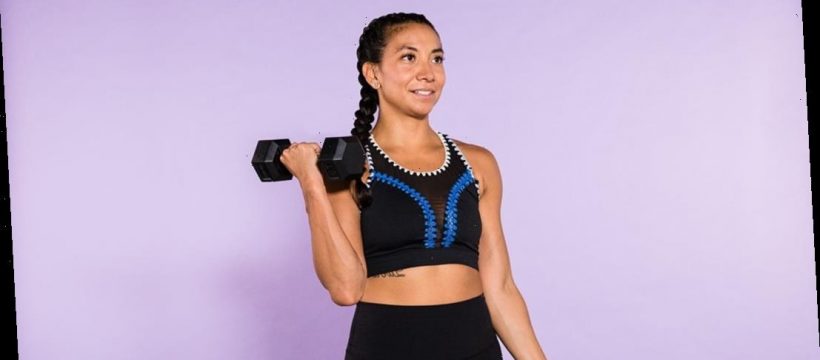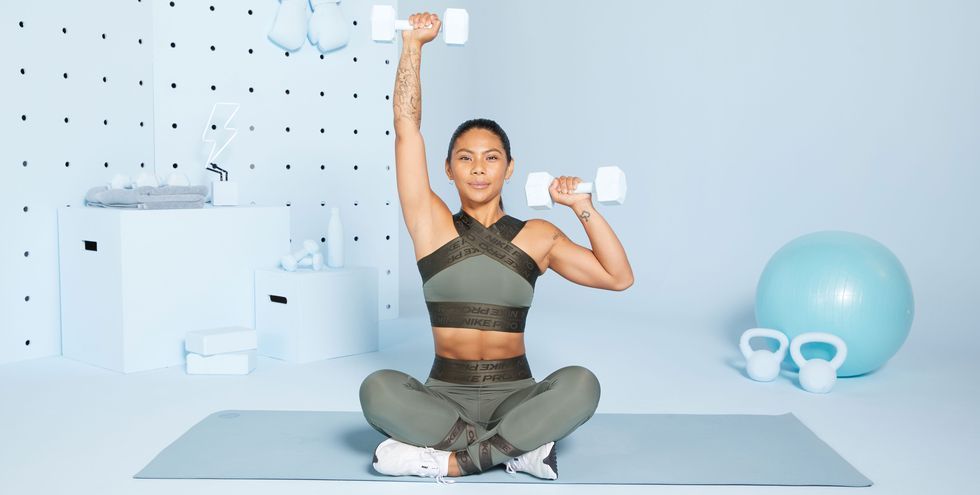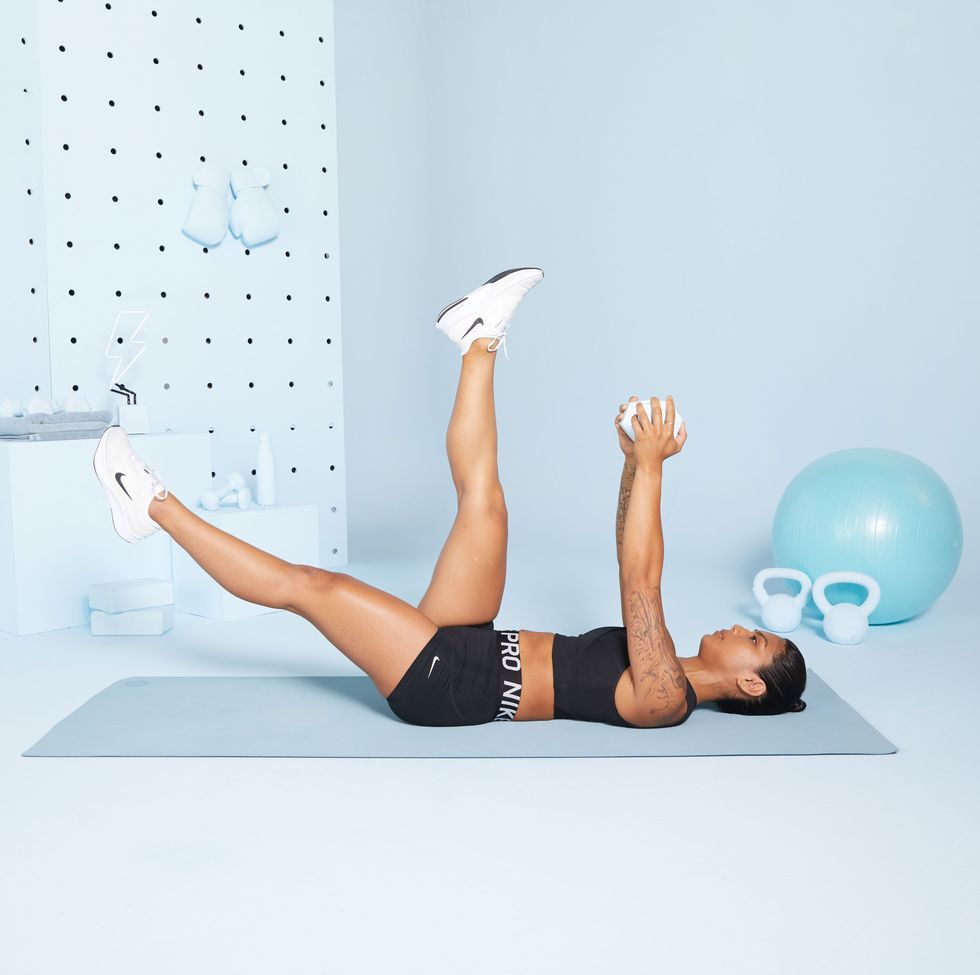Admit it: You’ve had dreams of sculpting arms á la Michelle Obama for ages (honestly, same). But getting toned arms can be a bit of a challenge.
Something that can help, though, is having top-notch advice from certified trainers for strengthening your arms like a champ. (Seriously, even Michelle will be proud once you’re done.)
1. Pick the right exercises
If you’re looking to tone your arms, your first instinct may be to pull out the weights and bust out 100 biceps curls. But isolated movements aren’t your fastest route to sculpted arms. “Generally speaking, if you’re looking to gain strength and see changes in your upper body, it’s best to start your session with a multi-joint exercise,” says Judine Saint Gerard, certified personal trainer and head coach at Tone House. “Think bent-over rows, pullups, chinups, and overhead presses.”
That said, there’s nothing wrong with including a couple single-joint moves (think: triceps kickbacks) as a supplement, says Saint Gerard. Just be sure to do these moves after the compound ones. “You don’t want to be too tired to perform the movements that will give you the most bang for your buck.”
Here’s a couple trainer-approved arm exercises to try at home (note: aim for three to five sets):
Bent-Over Row
How to: Grab a pair of dumbbells and stand with your feet hip-width apart, knees slightly bent. Hinge forward from your hips to lower your chest toward the floor, arms extended toward ground and palms facing each other. Brace your core, then pull the weights toward your rib cage, squeezing your shoulder blades together. Pause, then lower back to start. That’s one rep. Complete 8 to 10.
Seated Overhead Press
How to: Grab a kettlebell in each hand and sit on the ground with your feet crossed in front of you. Hold the weights just above your shoulders, palms facing each other. With the elbows pointed slightly forward instead of straight out to the sides, press the kettlebells up until they’re close together at the top but not touching. Rotate your arms so that your palms face forward. Hold for one second, then lower back to start. That’s one rep. Complete 8 to 10.
Pushup
How to: Bring yourself into a high plank position, with your feet to a bit wider than hip-width apart. This will give you more stability. Think about wrapping your shoulders back, but keeping your ribcage knit together. Everything is super engaged in your core. As you lower yourself down, elbows should point out at a 4:30 and 7:30. Don’t let your elbows flare out, but don’t keep them too narrow, either. Then push into your entire hand and press yourself back up. That’s one rep. Complete 8 to 10.
Upright Row
How to: With feet hip-width apart and legs straight, hold a pair of dumbbells in front of you, palms facing your body. Lift the dumbbells by raising your elbows until the weights reach your chest. Slide them back down to your thighs. That’s one rep. Complete 8 to 10.
Triceps Kickbacks
How to: Stand with your knees bent and lean forward at a 45-degree angle with a dumbbell in each hand. Start with your arms by your sides, bent at 90 degrees, weights at chest. Extend arms and press the dumbbells back. As you straighten your arms, squeeze your triceps. Return to start. That’s one rep. Complete 8 to 10.
Rear Delt Fly
How to: Grab a pair of dumbbells and stand with your feet hip-width apart and knees slightly bent. Hinge at the hips and let your arms hang straight down from your shoulders, palms facing your body. Raise both arms, in a “W” shape, out to the sides as you squeeze your shoulder blades together. Return to start. That’s one rep. Complete 8 to 10.
2. Don’t be afraid of heavy weights
Gone are the days of picking up tiny weights because you’re afraid of bulking up. That just isn’t going to happen unless you work really hard to do so, since women simply don’t have enough testosterone. “If you want definition, you need to train with a weight that actually stimulates your muscles and produces a training effect,” says Holly Rilinger, Nike master trainer and creator of the LIFTED method.
To do that, Rilinger says you should aim to perform 8 to 12 reps of your chosen exercise, which you can then repeat for three to five sets. “The last two reps in each set should be extremely difficult to finish without losing your form,” she explains. If it’s not—hooray!—you’ve beasted that weight and are ready for more.
3. Mix up your muscle groups
If you train the same muscle groups back-to-back, it can improve your endurance, but the combo can have a negative impact on your intensity—meaning you’re likely not getting the most out of your second exercise, because your muscles are fatigued by the first, says Saint Gerard. “Your best bet would be to alternate between different muscle groups to ensure each one gets adequate rest before attempting the next set,” she says. “That way, you’re always able to give your max effort and get the most out of the exercise.”
4. Pay attention to overall form
“I know it seems obvious, but I can’t tell you how often I see people tossing weight around improperly in ways that compromise results and risk injury,” says Jillian Michaels, celebrity fitness expert and creator of FitFusion.
A common offender: arching your back during bicep curls. If this is necessary, Michaels says your weight is too heavy. Once you’ve got the right resistance, “tuck your tailbone, pull your belly button in, and engage your core,” she says. “And don’t bring your elbows in front of your rib cage—that engages your anterior delts, not your biceps.” Noted.
5. Perk up your posture
Take a look in the mirror for a quick eval: Are your shoulders hunched forward or arched up by your ears? Williams says she often sees a lack of awareness or control over the scapula—a.k.a. shoulder—movements. “People are often hunching over in planks, pushups, and lat pulldowns instead of having a neutral spine,” she says.
To counteract that, make sure your chest and shoulders are open, and don’t be afraid to shrug the shoulders down and roll them back every few exhales to make sure your form is on point.
6. Work different angles of your arms
Try changing your hand position on some tried and true exercises. For example, rather than a biceps curl, try a hammer curl—a.k.a. palms facing towards each other—which will done a different area of your arm and help you avoid imbalances, explains Saint Gerard. Plus, “balance throughout a muscle is ideal for maximum strength and functionality, which will in turn improve the overall ‘look’ when the goal is to see changes in your upper body.”
Want to crank out a full arm workout? Try this great arm-toning routine:
7. Dial in your diet
If you’ve been killin’ it in the gym but you’re not seeing visual improvements in your arms, you may need to evaluate what’s happening in the kitchen. “Your body fat composition has to be low enough that you can see the muscles in your arms,” says Rilinger. “If you’re building muscle but eating poorly, you’ll still get stronger, but not more defined.”
In other words, keep an eye on your eats. Protein is the building block of muscle development, and it helps rebuild the muscle fibers that are torn during a workout, says Rilinger. Include it in each meal, as well as within 30 minutes of your sweat sesh, as that’s when you’re most primed for nutrient absorption. Otherwise, focus on veggies and healthy fats, and try to minimize the amount of processed foods and sugar you take in.
Source: Read Full Article



